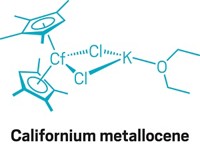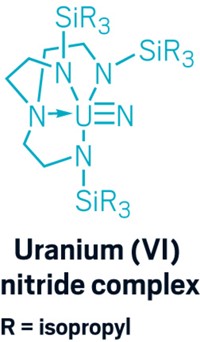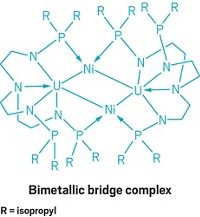Advertisement
Grab your lab coat. Let's get started
Welcome!
Welcome!
Create an account below to get 6 C&EN articles per month, receive newsletters and more - all free.
It seems this is your first time logging in online. Please enter the following information to continue.
As an ACS member you automatically get access to this site. All we need is few more details to create your reading experience.
Not you? Sign in with a different account.
Not you? Sign in with a different account.
ERROR 1
ERROR 1
ERROR 2
ERROR 2
ERROR 2
ERROR 2
ERROR 2
Password and Confirm password must match.
If you have an ACS member number, please enter it here so we can link this account to your membership. (optional)
ERROR 2
ACS values your privacy. By submitting your information, you are gaining access to C&EN and subscribing to our weekly newsletter. We use the information you provide to make your reading experience better, and we will never sell your data to third party members.
Synthesis
First Isolated Compound with a B=O Bond
by Stephen K. Ritter
March 28, 2005
| A version of this story appeared in
Volume 83, Issue 13

Of the elements in the first full row of the periodic table that are capable of forming a double bond with one another, the only missing pair has been boron and oxygen. But no longer, thanks to chemistry professor Alan H. Cowley of the University of Texas, Austin, who described the first isolated oxoborane (RB=O).
Cowley outlined several earlier attempts to make oxoboranes, including the synthesis of boron-containing heterocycles with bulky aryl, amido, or alkyl substituents that rearranged during attempts to create the B=O functional group. "While oxoboranes have been detected spectroscopically and their existence implied by the isolation of oligomers or decomposition products, such compounds have not been isolated previously," Cowley said. One problem has been the unwanted insertion of the oxoborane oxygen atom into a C–H bond of the supporting ligands.
As Cowley told his audience in San Diego, a new structural framework--and a roundabout synthesis--was needed. He and his coworkers selected the pentafluorophenyl-substituted β -diketiminate [C6F5NC(CH3)CHC(CH3)NC6F5]– as the supporting ligand for their oxoborane. They started by treating the protonated ligand (LH) with CH3AlCl2 to form LAlCl2, which was isolated in high yield.
The research team next carried out an exchange-autoionization reaction of this complex with BCl3 to give a salt, [LBCl][AlCl4], in quantitative yield. Hydrolysis of the salt with a stoichiometric amount of water in dichloromethane followed by elimination of HCl led to formation of the oxoborane isolated as an AlCl3 adduct, LB=O∙AlCl3. Details of the work have just been published (J. Am. Chem. Soc. 2005, 127, 4566).
The B–O bond length is 1.304 Å, but it's difficult to assign the bond order based solely on this one piece of data, Cowley related. One problem is that B–O single bonds, in compounds containing fragments such as N2B–O, are marginally longer, about 1.36 Å. These bond lengths also are highly dependent on the stereoelectronic characteristics of other substituents on the boron atom, he pointed out. But density functional theory calculations and additional analysis of the X-ray structural data "indicate that considerable boron-oxygen double-bond character is present in our compound," Cowley concluded.
"Cowley's work shows that this rare bonding motif indeed can be prepared," noted Jason A. C. Clyburne, an associate chemistry professor at Simon Fraser University, in British Columbia, who attended Cowley's lecture. "The boron-oxygen double bond is of interest to chemists because of its importance in many areas, including catalysis as well as glass," he added. "Some of the active sites on glass surfaces have been reported to include boron-oxygen double bonds." The isolation and characterization of the oxoborane sheds new light on bonding and "provides a rare data reference point for computational studies," Clyburne said.





Join the conversation
Contact the reporter
Submit a Letter to the Editor for publication
Engage with us on Twitter